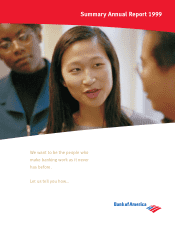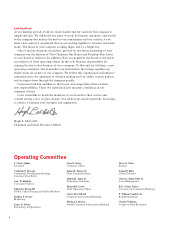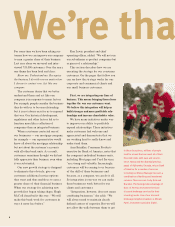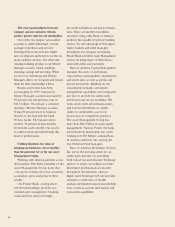Bank of America 1999 Annual Report Download - page 6
Download and view the complete annual report
Please find page 6 of the 1999 Bank of America annual report below. You can navigate through the pages in the report by either clicking on the pages listed below, or by using the keyword search tool below to find specific information within the annual report.
This is not a product strategy, a single business line strategy or a channel
strategy. It is a customer-focused relationship strategy that will guide our entire
company in all we do.
You can read more about how this strategy is being brought to life for each of
our primary customer and client groups later in this report. But, the bottom line
is this: We’ve spent the past 20 years building the largest footprint, the strongest
market share and the best customer and client base in America. Our job now is to
give 30 million customer households and 2 million business clients good reasons to
bring us more of their business.
By integrating our businesses, we will take the burden of aggregating our
products and services off our customers’ and clients’ backs and put it back where
it belongs: on our own. For years, banks have asked customers for more of their
business. Customers, however, have been required to do the hard work of obtaining
and managing each product or service separately.
We’ve been working to integrate our businesses for our commercial and
corporate clients over the past five years by appointing client managers to
coordinate the delivery of multiple products and services to individual clients.
Today, networking technology is enabling us to aggregate information for clients
and associates by building bridges within our infrastructure, making it easier to
understand and manage the full breadth of our relationships.
This same networking technology also will enable our retail and small business
customers to manage their relationships with us as one company. Personal bankers
and small business bankers, too, are gaining the ability to work with customers
within the context of the customer’s full relationship with the bank.
Integration of our businesses makes the second point in our strategy possible:
rewarding customers and clients for doing more business with us. This part of our
strategy may take many forms, from package pricing to enhanced service options to
simply letting customers know that we appreciate their decision to give us their
business. The point is, if we’re asking customers and clients to bring us more of
their business, we should be willing to reward them when they do.
The third part of our strategy is about setting priorities. In a fast-changing
competitive environment, we have to look hard and often at how we are deploying
our resources. We are ensuring that the businesses, products and projects in which
we are investing make sense within the context of our relationship strategy and are
creating value for customers, clients and shareholders. Making tough decisions
based on these criteria will bring focus and vigor to our efforts across the company.
Strong financial performance and new financial targets.
Looking at our business and financial accomplishments in 1999, the year was
something of an enigma. We produced a significant increase in earnings, fulfilling
the guidance we provided Wall Street in January, and continued to make good
progress on our merger transition and business strategy. Yet, our stock went down.
In 1999, your company had operating earnings of $8.2 billion, a 27 percent
increase over 1998, on record revenues of $32.5 billion. We achieved this improvement
through favorable operating leverage. That is, we increased revenues by 6 percent
through healthy advances in such fee-based businesses as investment banking,
deposit services, card services and mortgage banking. At the same time, we reduced
expenses by 4 percent, primarily as a result of our successful consolidation efforts
in the wake of recent mergers. Our credit losses declined by almost $500 million,
allowing us to lower provision expense.
4
96 97 98 99
1.37
1.20
1.59
1.85
96 97 98 99
14.5
15.9
17.0
17.7
Dividends
(Dollars per share)
Return on average
common equity
(operating basis)
(Percent)



















